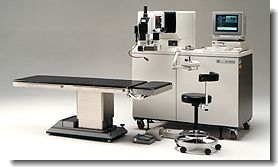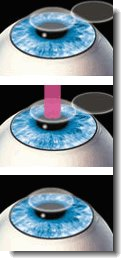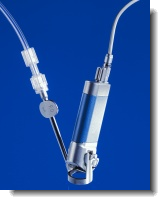

While the surgeon "charges up" the laser (and while the laser is in contact with the eye), you will hear a repetetive "popping" or "clicking" sound which is normal. Keep in mind that while the doctor controls the laser, the computer is still doing most of the work (i.e. laser pulse calculations based on your specific procedure). However, the doctor will double check the figures entered into the computer to make absolutely sure they are correct.
What To Expect During Lasik Eye Surgery:
Here's what to expect just before, and during an actual lasik eye surgery procedure:
2. The suction ring is now placed directly onto the eye, perfectly centered. The doctor will then ask his/her assistant for suction, and the machine's suction function will be activated. When applied, the suction will prevent you from seeing for just a few seconds as the microkeratome passes over your eye.
3. Before the microkeratome performs its magic, the surgeon will squirt saline solution into the middle of the suction ring for lubrication.
4. With the suction ring in place and properly lubricated, the surgeon will now guide the microkeratome across the track of the suction ring to create the corneal flap. This is virtually painless.
5. The flap is then gently lifted and folded over, exposing the cornea (or stroma).
6. The eximer laser is now activated. Most patients do not even see the laser beam, others report a very pale blue light. You will again hear the "popping or clicking" of the laser, but this is normal and nothing to be concerned about.
7. The actual length of time the laser is active depends on your particular needs, but it will generally be for 30 to 60 seconds. As the laser is active, your doctor will count down the seconds for you, so you will know exactly how much time has gone by and how much time is left.
8. That's it, the laser portion of the procedure is done!
9. The doctor applies more saline solution to clear any dust or debris, and folds the flap back to its original position.
10. A specially designed "merocel" sponge is used to smooth any wrinkles in the flap and to ensure the cap is properly placed.
11. You may notice that your vision has now improved greatly! Although, your vision may be slightly blurry at first, but over the next 24 hours your vision will become clearer and clearer.
Congratulations, you've just successfully completed lasik eye surgery!
3. Before the microkeratome performs its magic, the surgeon will squirt saline solution into the middle of the suction ring for lubrication.
4. With the suction ring in place and properly lubricated, the surgeon will now guide the microkeratome across the track of the suction ring to create the corneal flap. This is virtually painless.
5. The flap is then gently lifted and folded over, exposing the cornea (or stroma).
6. The eximer laser is now activated. Most patients do not even see the laser beam, others report a very pale blue light. You will again hear the "popping or clicking" of the laser, but this is normal and nothing to be concerned about.
7. The actual length of time the laser is active depends on your particular needs, but it will generally be for 30 to 60 seconds. As the laser is active, your doctor will count down the seconds for you, so you will know exactly how much time has gone by and how much time is left.
8. That's it, the laser portion of the procedure is done!
9. The doctor applies more saline solution to clear any dust or debris, and folds the flap back to its original position.
10. A specially designed "merocel" sponge is used to smooth any wrinkles in the flap and to ensure the cap is properly placed.
11. You may notice that your vision has now improved greatly! Although, your vision may be slightly blurry at first, but over the next 24 hours your vision will become clearer and clearer.
Congratulations, you've just successfully completed lasik eye surgery!


After your pre-op exams have been completed, you will be given a set of eyedrops-one to anesthetize your eye, one to prevent infection, and a third to control postoperative inflammation. You are then escorted to the surgery room and comfortably reclined on the laser bed, beneath the laser microscope. Some doctors will use a surgical drape to cover the eyelids and keep the eyelashes away from the cornea.
Next, an eyelid speculum will be used to keep your eyelids apart. This may sound bad, but it really isn't painful. Some patients say the feeling is a little odd at first, but not particularly uncomfortable.
Next, an eyelid speculum will be used to keep your eyelids apart. This may sound bad, but it really isn't painful. Some patients say the feeling is a little odd at first, but not particularly uncomfortable.

You will now be asked to stare into the microscope at a red or green blinking light (depending on which type of laser is used). A circle of light surrounds the light, and the surgeon will ask if you can see it. You will need to stare into that light, and keep your eye still, when prompted to do so. Do not worry if you accidentally move your eye, as the doctor is in complete control and can stop the laser at any time. You will be asked to refocus on the light, and the computer will continue exactly where it left off.
Above: The Microkeratome Assemby
Above:
The Basic 3 Step Process In LASIK Surgery.
The Basic 3 Step Process In LASIK Surgery.
Above:
A Basic Laser Eye Surgery Operating Area. The Doctor Usually Sits Behind You.
A Basic Laser Eye Surgery Operating Area. The Doctor Usually Sits Behind You.
1. The surgeon will first mark your cornea with the optical zone or LASIK marker, and place a "hatch" mark at two points around the circle (to ensure proper placement of the hatch when the operation is finished).
The "microkeratome pass" that creates a thin corneal flap takes mere seconds, but is the most critical step in the surgery and begins after the equipment check. Keep in mind that "bladeless" flap creation is also available, which uses a laser to create the flap instead of a blade. This procedure is not available at all laser eye clinics and can usually cost more.
Also See:
In PRK, a flap is not created. Instead, the surgeon completely removes the corneal layer, then applies the laser. The layer grows back in 3 to 5 days. See "types of laser eye surgery" and "laser eye surgery videos" for more details.
PRK Is Different....
The Procedure Begins:
The doctor and/or technicians will also double check the following to make sure they are in perfect working order:
Microkeratome Assembly
Microkeratome Blade
Suction Ring
Smoothness Of The Microkeratome's Gears
Microkeratome Assembly
Microkeratome Blade
Suction Ring
Smoothness Of The Microkeratome's Gears
Contact Lenses | Glaucoma | Just For Fun | Eyeglasses | Eye Doctor | Eye Care And Symptoms | Eye Anatomy | Online Eye Tests | Laser Eye Surgery | Laser Eye Surgery Directory: Canada | Laser Eye Surgery Directory: USA | Laser Eye Surgery Reviews | Submit A Review | Contact Us | Privacy Policy | Sitemap
Copyright 2006-2010 Vision Health

